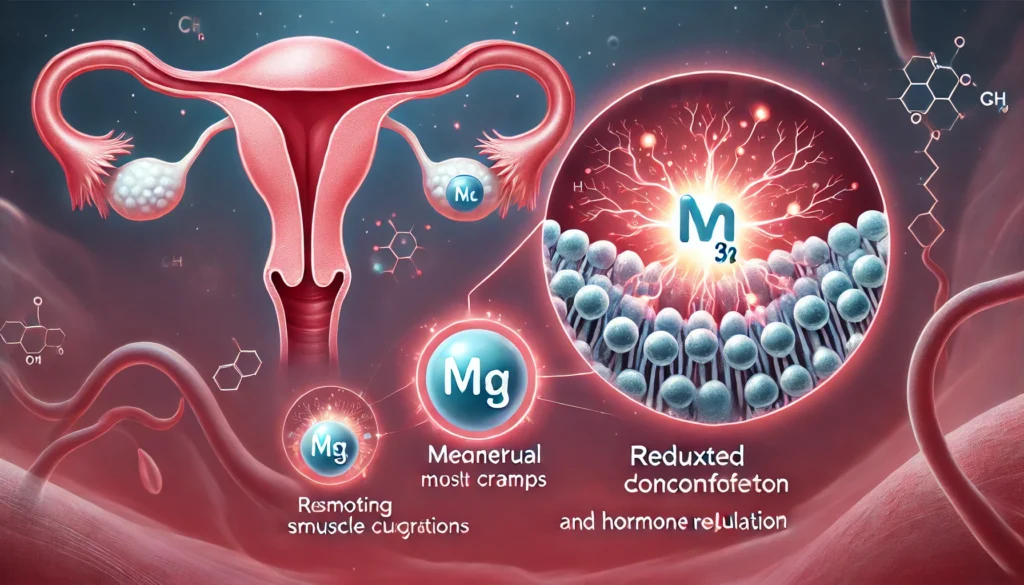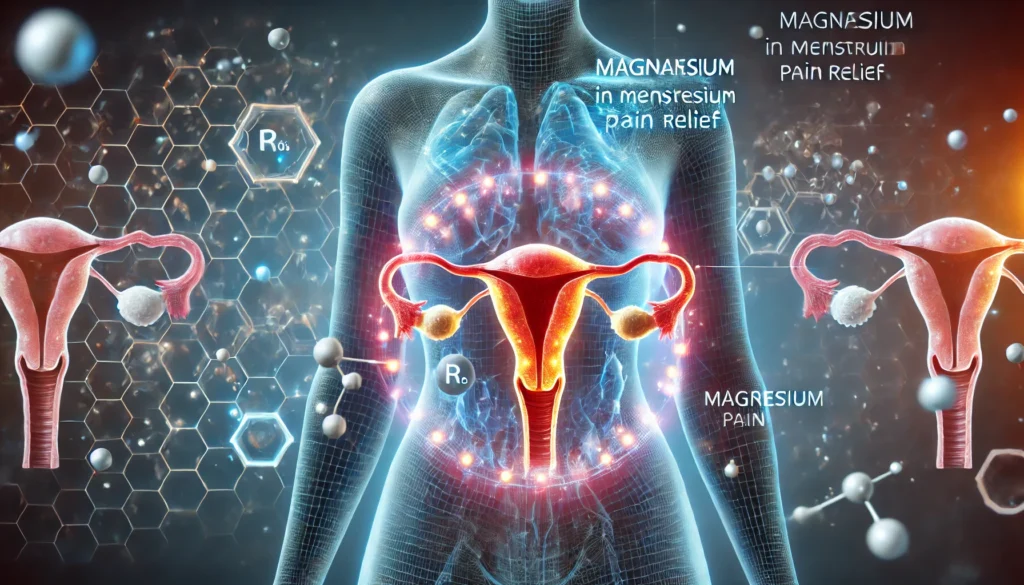Navigating the world of menstrual health can often feel like traversing a minefield, especially when it comes to alleviating menstrual pain. One of the most promising yet frequently overlooked remedies is magnesium. This essential mineral not only plays a crucial role in numerous bodily functions but has also been found to potentially ease menstrual discomfort. In this article, we will delve into the science behind magnesium and its impact on menstrual pain, exploring historical contexts, current research, and future possibilities.
You may also like: Essential Oils for Emotional Well-Being
Understanding Menstrual Pain
Menstrual pain, also known as dysmenorrhea, affects a significant portion of menstruating individuals, often disrupting daily life and productivity. The pain, which is typically concentrated in the lower abdomen, can range from mild to severe and is usually accompanied by symptoms such as nausea, fatigue, and irritability. Although nonsteroidal anti-inflammatory drugs (NSAIDs) and hormonal contraceptives are commonly prescribed treatments, many seek alternative methods due to potential side effects or inadequate relief.
The Prevalence and Impact of Dysmenorrhea
Dysmenorrhea is one of the most common gynecological conditions, affecting up to 90% of menstruating women at some point in their lives. The condition can lead to missed school days and decreased work productivity, significantly impacting quality of life. Understanding its prevalence underscores the importance of finding effective treatments.
Physical and Emotional Symptoms
Beyond physical discomfort, menstrual pain often brings emotional symptoms such as mood swings, anxiety, and irritability. These emotional symptoms can exacerbate the physical pain, creating a cycle of discomfort that affects overall well-being. Addressing both physical and emotional aspects is crucial for comprehensive menstrual health management.
Limitations of Conventional Treatments
While NSAIDs and hormonal contraceptives are effective for some, they are not without limitations. Many individuals experience side effects, such as gastrointestinal issues or hormonal imbalances, prompting the exploration of more natural remedies like magnesium. Moreover, these treatments may not address underlying causes of pain, making symptom management an ongoing challenge.
The Role of Magnesium in the Body
Magnesium is a vital mineral involved in over 300 enzymatic reactions in the body, including those critical for muscle and nerve function, blood sugar control, and blood pressure regulation. In the context of menstrual health, magnesium’s ability to relax muscles, reduce inflammation, and balance hormones makes it a potential ally in alleviating period pain.
Magnesium’s Importance in Daily Health
Magnesium is essential for maintaining overall health, supporting processes such as energy production, DNA synthesis, and bone health. Despite its importance, many people fail to get sufficient magnesium from their diet, highlighting the need for awareness and supplementation. Ensuring adequate magnesium intake is fundamental not only for menstrual health but for overall bodily functions.
Interaction with Other Minerals and Vitamins
Magnesium works synergistically with other nutrients, such as calcium and vitamin D, to support various bodily functions. This interaction is crucial in maintaining balanced mineral levels, as they collectively influence muscle contraction, nerve transmission, and bone strength. Understanding these interactions can inform better dietary and supplementation choices.
Magnesium Deficiency: Signs and Risks
Magnesium deficiency is often overlooked, yet it can lead to a range of health issues, including muscle cramps, fatigue, and mental health disorders. Recognizing the signs of deficiency is vital for timely intervention and prevention of more severe health problems. Increasing awareness of magnesium’s role can empower individuals to make informed health decisions.

Historical Context and Emerging Trends
Historically, magnesium has been recognized for its therapeutic properties. Ancient civilizations often utilized magnesium-rich foods and salts for medicinal purposes. In recent years, scientific interest in magnesium has surged, particularly in relation to its effects on menstrual health. Modern research continues to explore and affirm magnesium’s potential in reducing menstrual pain and associated symptoms.
Ancient Uses of Magnesium
In ancient cultures, magnesium-rich compounds were often used for their healing properties, with applications ranging from skin treatments to digestive aids. These early uses laid the groundwork for contemporary understanding of magnesium’s health benefits. Historical practices offer valuable insights into natural remedies that have stood the test of time.
The Renaissance of Natural Remedies
In the modern era, there is a growing shift towards natural and holistic health solutions, driven by concerns over synthetic medications’ side effects. This renaissance has brought traditional remedies like magnesium back into the spotlight. The trend reflects a broader movement towards integrative health approaches that combine the best of traditional and modern medicine.
Modern Research and Magnesium’s Rising Popularity
The past decades have seen a rise in scientific studies examining magnesium’s health benefits, particularly its role in women’s health. This research is paving the way for magnesium to become a mainstream treatment option for menstrual pain. As evidence accumulates, healthcare providers may increasingly recommend magnesium as part of a comprehensive treatment plan.
How Magnesium Alleviates Menstrual Pain
Muscle Relaxation and Pain Reduction
One of magnesium’s primary benefits is its ability to relax smooth muscles, which can help alleviate the uterine contractions responsible for menstrual cramps. By acting as a natural calcium blocker, magnesium prevents excessive muscle contractions, thereby reducing the intensity of cramps.
Mechanisms of Muscle Relaxation
Magnesium influences muscle relaxation by competing with calcium, which is responsible for muscle contraction. By limiting calcium’s action, magnesium helps maintain relaxed muscle fibers, reducing cramp severity. This mechanism is particularly relevant for uterine muscles, which contract during menstruation.
Comparative Effectiveness
Studies have shown that magnesium can be as effective as some NSAIDs in reducing menstrual cramps, offering a natural alternative for those seeking relief. This effectiveness makes it a compelling option for individuals concerned about the long-term use of pharmaceuticals. Integrating magnesium into pain management strategies can provide a holistic approach to menstrual health.
Individual Responses to Magnesium
While many find relief with magnesium, individual responses can vary based on factors like magnesium levels, diet, and overall health. Personalized approaches to magnesium supplementation are essential to maximize benefits and address specific needs. Consulting with healthcare professionals can help tailor magnesium intake to individual circumstances.
Inflammation Reduction
Magnesium also plays a role in reducing inflammation, a key contributor to menstrual pain. It modulates inflammatory markers and can help decrease the production of prostaglandins, lipid compounds that trigger pain and inflammation during menstruation.
Understanding Prostaglandins
Prostaglandins are hormone-like substances that induce uterine contractions and inflammation, intensifying menstrual pain. Magnesium’s ability to reduce prostaglandin production can significantly alleviate these symptoms. By targeting inflammation at its source, magnesium offers a proactive approach to pain management.
Broader Anti-Inflammatory Effects
Beyond menstrual health, magnesium’s anti-inflammatory properties contribute to its benefits in conditions like arthritis and cardiovascular disease. This broad spectrum of effects highlights magnesium’s role in maintaining overall health. Incorporating magnesium into daily routines can support both menstrual and general well-being.
Clinical Evidence Supporting Magnesium’s Role
Clinical studies have consistently demonstrated magnesium’s effectiveness in reducing markers of inflammation, supporting its use in menstrual pain relief. These findings provide a robust foundation for recommending magnesium as a part of comprehensive treatment plans. Continued research will further elucidate its role in inflammation management.
Hormonal Balance
Furthermore, magnesium assists in balancing hormones, particularly by supporting the production and regulation of estrogen and progesterone. Hormonal imbalances are often linked to severe menstrual symptoms, so maintaining optimal levels can help alleviate discomfort.
The Role of Estrogen and Progesterone
Estrogen and progesterone are critical in regulating the menstrual cycle, and imbalances can lead to symptoms like heavy bleeding and severe cramps. Magnesium supports the synthesis and function of these hormones, promoting a balanced hormonal environment. This balance is crucial for minimizing menstrual discomfort and improving overall cycle health.
Magnesium’s Influence on Mood and Stress
In addition to regulating reproductive hormones, magnesium plays a role in neurotransmitter function, influencing mood and stress levels. By supporting serotonin production, magnesium can help alleviate mood swings and anxiety associated with PMS. This dual action on hormones and mood makes magnesium a valuable ally in menstrual health.
Practical Strategies for Hormonal Support
Incorporating magnesium through diet or supplements can support hormonal health, but it’s also essential to consider lifestyle factors like stress reduction and sleep quality. These elements work synergistically with magnesium to maintain hormonal balance and enhance menstrual health. A holistic approach can optimize benefits and improve quality of life.

Current Research and Scientific Evidence
Several studies have investigated the efficacy of magnesium in reducing menstrual pain. A randomized controlled trial published in the Journal of Women’s Health found that participants who supplemented with magnesium experienced a significant reduction in pain intensity compared to those who received a placebo. Another study in the Journal of Obstetrics and Gynecology Research concluded that magnesium supplementation effectively decreased the severity and duration of menstrual cramps.
Overview of Recent Studies
Recent research has focused on understanding how magnesium interacts with the body’s pain pathways to provide relief during menstruation. These studies have consistently shown positive outcomes, reinforcing magnesium’s role in menstrual health. Continued research is vital to deepen our understanding and refine recommendations.
Critiques and Considerations
While the evidence supporting magnesium’s benefits is strong, some studies highlight the need for larger sample sizes and longer durations to confirm results. Addressing these limitations is crucial for establishing comprehensive guidelines. Researchers are called to expand their investigations to provide more definitive answers.
Future Directions in Research
Emerging research areas include exploring magnesium’s role in different populations and its long-term effects on menstrual health. These studies will help tailor recommendations and improve the precision of treatment protocols. As research progresses, magnesium may become a staple in menstrual health management.
Which Magnesium is Best for Menstrual Cramps?
Magnesium comes in various forms, each with unique properties and absorption rates. For menstrual cramps, magnesium citrate and magnesium glycinate are often recommended due to their high bioavailability and gentle impact on the digestive system. It’s important to consult with a healthcare provider to determine the appropriate dosage and form for individual needs.
Differences Between Magnesium Forms
Each form of magnesium offers distinct advantages, with citrate and glycinate being the most commonly recommended for menstrual pain due to their absorption rates. Understanding these differences can help individuals make informed decisions about which form to choose. Consulting with healthcare professionals is essential for personalized guidance.
Dosage and Safety Considerations
Determining the correct dosage is crucial to maximizing benefits while minimizing potential side effects like diarrhea or digestive discomfort. Starting with a lower dose and gradually increasing can help individuals find their optimal level. Professional guidance ensures safe and effective supplementation.
Personalized Magnesium Strategies
Individual health conditions and dietary habits can influence the effectiveness of magnesium supplementation. Tailoring magnesium intake to personal needs can enhance its efficacy and address specific menstrual health concerns. Personalized strategies empower individuals to take control of their health.
Practical Advice for Incorporating Magnesium
Dietary Sources
Incorporating magnesium-rich foods into the diet is a practical way to support menstrual health. Foods such as leafy greens, nuts, seeds, whole grains, and legumes are excellent sources of magnesium. Additionally, dark chocolate and avocados can provide a delicious boost to magnesium intake.
Creative Ways to Include Magnesium-Rich Foods
Exploring diverse recipes and meal plans can make it easier to incorporate magnesium-rich foods into everyday diets. Smoothies, salads, and grain bowls offer versatile ways to enjoy these nutritious options. Creativity in the kitchen can transform magnesium intake into a delightful experience.
Seasonal and Local Options
Choosing seasonal and locally sourced magnesium-rich foods can enhance both nutritional value and sustainability. Local produce often retains higher nutrient levels due to shorter transportation times. Supporting local agriculture while boosting magnesium intake benefits both health and the environment.
Overcoming Dietary Challenges
For individuals with dietary restrictions, finding alternative magnesium sources, such as fortified foods or plant-based supplements, can ensure adequate intake. Addressing dietary challenges proactively can prevent deficiencies and support optimal health. Tailored solutions make magnesium accessible to everyone.
Supplementation
For those who struggle to meet their magnesium needs through diet alone, supplementation can be a beneficial option. It is essential to choose high-quality supplements and adhere to recommended dosages to avoid potential side effects like digestive discomfort.
Choosing the Right Supplement
The market offers a wide range of magnesium supplements, making it important to select products that prioritize quality and bioavailability. Third-party testing and certification can provide assurance of supplement quality. Informed choices ensure effective and safe supplementation.
Timing and Absorption
Taking magnesium supplements at the right time can enhance absorption and effectiveness. Some forms are best absorbed on an empty stomach, while others may be more effective with food. Understanding these nuances can maximize the benefits of supplementation.
Monitoring and Adjusting Intake
Regularly assessing magnesium levels and adjusting intake as needed can help maintain optimal health. Blood tests and symptom tracking provide valuable insights into magnesium needs. Ongoing monitoring ensures that supplementation remains effective and beneficial.
Lifestyle Considerations
In addition to dietary changes, lifestyle modifications such as regular exercise, stress management, and adequate hydration can enhance magnesium’s effectiveness in reducing menstrual pain.
The Role of Exercise
Physical activity can improve circulation and reduce stress, complementing magnesium’s muscle-relaxing effects. Incorporating regular exercise into daily routines supports overall menstrual health. Finding enjoyable activities can make exercise a sustainable habit.
Stress Reduction Techniques
Stress management practices, such as meditation, yoga, or deep breathing exercises, can amplify magnesium’s mood-stabilizing benefits. Reducing stress levels can significantly impact menstrual pain and emotional well-being. Integrating these practices into daily life enhances holistic health.
Importance of Hydration
Staying hydrated is vital for maintaining electrolyte balance and supporting magnesium’s functions in the body. Proper hydration can prevent cramps and other menstrual symptoms. Establishing a consistent hydration routine contributes to overall health and wellness.

Future Implications and Conclusion
As our understanding of magnesium’s role in menstrual health continues to evolve, it holds promise as a natural and effective remedy for menstrual pain. Ongoing research may further elucidate its mechanisms and broaden its applications in women’s health.
The Potential for Broader Applications
Beyond menstrual health, magnesium’s diverse benefits suggest potential applications in other areas of women’s health, such as menopause and pregnancy. Exploring these possibilities could expand magnesium’s role in holistic women’s health care. As research progresses, magnesium’s versatility may become more widely recognized.
Integrating Magnesium into Health Strategies
Incorporating magnesium into broader health strategies requires collaboration between healthcare providers, researchers, and patients. This integration can enhance the effectiveness of treatment plans and improve patient outcomes. Collaborative efforts will drive innovation in women’s health care.
Embracing a Natural Approach to Health
Emphasizing natural remedies like magnesium aligns with a growing movement towards sustainable and holistic health solutions. This approach encourages individuals to take an active role in their health and well-being. By embracing natural options, we can foster a healthier and more balanced lifestyle.
In conclusion, magnesium represents a multifaceted approach to managing menstrual discomfort. By integrating scientific insights with practical strategies, individuals can harness the power of this essential mineral to improve their menstrual health and overall well-being.
Further Reading:
What Supplements Help with PMS?
6 Best Supplements for Period Cramps
Magnesium for PMS: Your Natural Solution to Monthly Discomfort
Important Note: The information contained in this article is for general informational purposes only, and should not be construed as health or medical advice, nor is it intended to diagnose, prevent, treat, or cure any disease or health condition. Before embarking on any diet, fitness regimen, or program of nutritional supplementation, it is advisable to consult your healthcare professional in order to determine its safety and probable efficacy in terms of your individual state of health.
Regarding Nutritional Supplements Or Other Non-Prescription Health Products: If any nutritional supplements or other non-prescription health products are mentioned in the foregoing article, any claims or statements made about them have not been evaluated by the U.S. Food and Drug Administration, and such nutritional supplements or other health products are not intended to diagnose, treat, cure, or prevent any disease.


